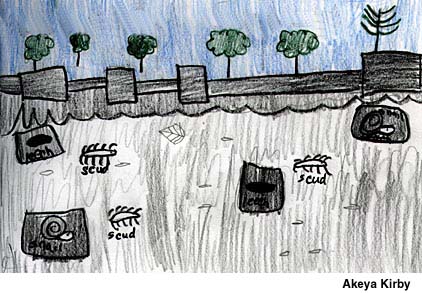Stream
Quality
Flip
Rocks! / Benthic Organisms
 Overview
Overview
Introduce benthic organisms (creatures that live on the bottom
of streams) as indicators of water quality. By monitoring benthic
organisms we get an excellent picture of life in the stream over
time. We get a general sense of water quality, which can be further
explored by chemical testing.
Objectives
Introduce typical organisms for local stream conditions. For instance,
in a typical urban, Pennsylvania, spring-fed stream one can find
planarians, gammerus or scud, snails, and isopods. The presence
of benthic organisms can indicate: diversity as a sign of a healthy
environment, some organisms are known to exist in comparatively
clean waters (such as gammerus), whereas others are more tolerant
to pollution (such as planarians).
Estimated
Duration
1 to 1.5 hours
Lesson
Plan
Class
setting
Students work in small groups.
Script
of class interactions
Have the students collect around the stream. Explain the safety
issues and the need to be careful when working around streams
with potentially suspicious water quality. Explain the need to
wash well after working in the stream. Explain that no food, candy
or gum should be consumed while working with the stream, or until
after they have cleaned their hands.
Hand
out the sampling pans and distribute materials to the students.
Have them gather around the stream and pay attention as you demonstrate
a safe and sensitive manner of disturbing the benthic organisms
home. Remember if you pick a rock put it back where you found
it. Return all living creatures to the stream carefully, after
you study.
Display
and Teaching Materials
Use the accompanying field book
See drawings of benthic organisms
Review supplemental background information on classifying creatures.
| Activity:
Flip Rocks! |
|
Demonstrate
how to find benthic organisms. The easiest method with the
least equipment is to simply choose some likely rocks in
shallow but moving water. Pick up a stone and look at the
underside, "wigglers" of all sorts are likely to be found
and can be carefully nudged, picked and pushed into the
collecting cups or directly into the sampling pan.
|
| Observe
the benthic organisms closely using a magnifying lens. Look
for body structure: |
Does it have legs?
How many legs does it have?
|
How
does it move?
|
Does
it have a head?
|
What
color is it?
|
| Observe
the environmental context for these benthic organisms: |
Are they
in a shady or sunny area?
|
Is the bottom
gravel or sand?
|
Is the
water shallow or deep?
|
Is the
water moving really fast or sort of slow?
|
Are their
trees or grass along the stream banks?
|
Are there
any manmade objects nearby?

(text by 5th grade student)
|
| |
| Observe
the different kinds of benthic organisms. |
How many
different kinds have you found?
|
Are they
wigglers, crawlers, backstrokers or blobs?
|
Are you
seeing a lot of one kind and a few of another?
|
Draw
the benthic organisms, make detailed drawings, noting all
of the above.
 |
|
| |
Dickson
Intermediate School
Drawings by 5th grade students |
|
|
| |
![]()

 Overview
Overview


